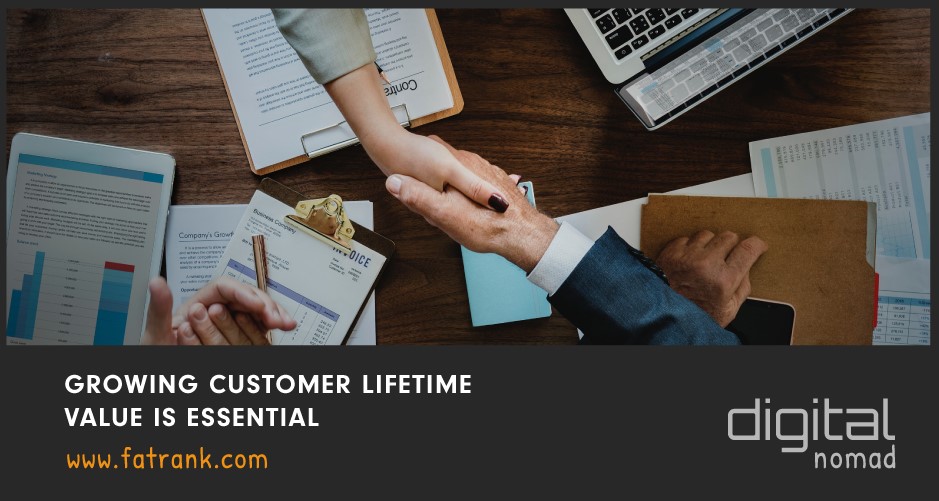
Growing Customer Lifetime Value Is Essential
Growing your Customer Lifetime Value is such an essential element to growth.
CLV (Customer Lifetime Value) is the most important metric that a lot of companies ignore.
So many businesses in this day and age are obsessed with new customers instead of looking to upsell, cross-sell and downsell to their existing clients.
In business, the key to success is to work smarter and not necessarily harder to grow company profits.
Contents
- Upsells, Downsells & Cross-Sells And Why You Should Start Using Them
- What is An Upsell?
- What is Downsell?
- What is Cross-Sell?
- What is Your Customer Lifetime Value?
- How to Calculate Lifetime Value of a Customer?
- So Dooley What Commission Would You Pay For a New Client?
- Companies Lack In-House Skills
- A Few Bonus Tips
- Conclusion
- All Growth Hacking Related Posts
Upsells, Downsells & Cross-Sells And Why You Should Start Using Them
Most people who don’t understand Average Order Value think they need to go out and buy more traffic. This could get you the growth you’re after but it will also increase your expenses. Your net profit may be the same.
But what if I told you it was possible to increase your AOV without having to buy more traffic?
Well, the way you get these kinds of results is by adding Upsells, Downsells and Cross-sells to your existing client base.
What is An Upsell?
An upsell is anything that increases your customer’s spending on your products or services.
An easy example of this is if you looked to buy a new GoPro camera then you would try to upsell the memory card and waterproof GoPro cases.
Adding these extra products to the purchase will increase sales and profits.

Another example is on lead generation that if someone wanted to take out a mortgage then you could upsell services like conveyancing which is needed with every mortgage.
Adding this extra service adds to your turnover and profits because not costing you any more marketing as you are already speaking to this customer.
What is Downsell?
A downsell is also something that can increase your AOV, despite having the word down in the name.
This technique is used when the customer (for whatever reason) decides to back down from the purchase. In this case, you can offer them a cheaper product, which has higher chances of being accepted. The goal here is to acquire a customer, even if you will not profit as much as possible right away.
Your initial upsell might have been asking too much from the client so now you offer something cheaper to add extra revenue to the order.
What is Cross-Sell?
A cross-sell is where you think outside the box and try to connect various niches that can be linked into the initial order you receive.
When you use a cross-sell you are simply offering a product that you know your customer will be interested in based on the product they have purchased from you.
An example of this is you have received the enquiry again for a mortgage and closed the deal to help a couple buy their first home.
Then the cross-sell is thinking outside the box on what other services they might consider in this situation. Here are some examples:
- Life Insurance (if they are taking out a mortgage together then life cover will pay off the mortgage if one was to pass away)
- Home Insurance (obviously they have just bought a new house so will be needing home insurance)
- Wills / Lasting Power Of Attorney (they will need to make sure now they have a valuable asset they sign this over to who they want should they pass away)
- Gas / Electric Supplier (maybe send them an affiliate link to say these are the most competitive)
- TV / Broadband (big commissions in affiliate to sign up new clients for television and internet connections)
- Many other services like van rental for moving equipment, driveway contractors, artificial grass for the garden and much more
The power of utilising your existing database and client base is key to growing your profits.
The really great thing about all of these strategies, is they allow you to increase your revenue without having to purchase more traffic. When you maximize the return you get on your existing customers you are truly getting everything you can out of all you’ve got.
What is Your Customer Lifetime Value?
If you are reading this and you do not know what your customer lifetime value is and how you can improve it then go and bang your head against the wall before reading on.
No, but seriously existing clients should be a huge part to your sales in cross-selling them semi-related services, down selling them products they might need and upselling them a premium addition to their existing purchases.
The definition of Customer Lifetime Value is simple: Customer Lifetime Value represents a customer’s value to a company over a period of time.

Customer lifetime value is very important because it represents exactly how much each customer is worth in monetary terms, and therefore exactly how much a marketing department should be willing to spend to acquire each customer as they have worked out the average value per client.
So if you have a customer come and buy from you, then you never upsell or deal with any after sales you are losing potential further revenue from these and bear in mind they already know who you are and are more than likely happy because they have bought from you before.
How to Calculate Lifetime Value of a Customer?
When looking you calculate the Lifetime Value of a Customer you need to work out:
- Average order value sum
- Profit margin
- The attrition rate (percentage who will rebuy)
- Length of attrition (how many rebuys a customer in his life does on average)
LTV Calculation for SEO Contract
So let’s say we take this model above for working out an SEO Customer LTV value:
- 2k per month payment
- 1k profit (so spend 1k on content and links and 1k is profit)
- 25% of clients renew a contract
- 12-month contract
So working on this model above a client makes you 12k on a contract and 25% resign so your lowest LTV value there is 15k profit for that customer.
The truth is that the 15k is lowest because the year after then another 25% will resign again of your existing client base which would increase the LTV further.
LTV Calculation for Link Building Service (one-off buys)
So on this model we have no contract in place and want to work out the LTV value of one-off purchases:
- £200 outreach link payment
- £50 profit (costs £150 for placement and £50 profit)
- 26 backlinks average (after years of trading you can work out how many links on average a customer purchases)
This model tells you a client lifetime value is £1300 on average (26 x £50 = £1300).
Many marketers only look at the profit margin they make on their first sale but this is crazy because above you can see an average customer is worth £1300 to their business and not just the £50 profit on that first order.
Disclaimer: Obviously the average price means some might only have the value of £50 to your company and others could be worth 10k. So please do not work out the cost you can purchase a new client for on this average LTV figure.
So Dooley What Commission Would You Pay For a New Client?
Close friends who run very successful online agencies have asked this question a few times recently.
These agencies are looking to grow their client base and see what is sensible figures to work out the CPA of a new client or bonus structure to their staff.
My advice on this would be something along these lines:
- I would happily pay the full profit of customers first purchase (so the example above would pay £50 for a new link building client). Which basically on my companies figures means the first order is zero profit and we need to try and get the funnels working for them to rebuy.
- I would probably be happy once the funnels I know are working nicely and established my processes do it for multiple sales profit (but only when I knew my average attrition rate)
- Inhouse sales team could get a CPA revenue of the first sale profit made
- Sales team inhouse could get a HYBRID model where get a small CPA and small recurring revenue share
- Inhouse sales team could get a REV SHARE model where get higher recurring revenue share but no signup CPA
There is not a one size fits all system though as us humans are all driven differently so it is about working out your staff if hiring inhouse.
Companies Lack In-House Skills
The reason so many companies fall short on improving their CLV is because they lack the systems and processes.
There should be processes in place to upsell, down sell and cross-sell to your clients.
The lack of in-house skills means the business strategy needs to produce actionable plans for after-sales or linking services to the initial enquiry.
A Few Bonus Tips
Adapt to the strategy of Tripwire marketing. It involves segmenting your leads into interest groups, selling them into a low priced item and then up-selling those who buy into one of your main products or services. Here is an example if you deal with schools and want to sell them a service you offer like fencing:
- Start with a lead magnet – Offer them something for free like a free site survey while you are in the area or free funding advice
- Create the tripwire – Once you get talking to the school educate them how you have helped thousands get funding grants
- They are missing out – As they are missing out they now want to see whether they can get funding for this
- The competition kicks in – They now have it in their head they want this and even if not successful could order your fencing
- Introduce other services – Get your cross-selling hat on
- Rinse and Repeat but start to throw in scarcity marketing to make them feel this is limited
The lead magnets are key because if you start the email, call, text message or outreach with a hard sell then you will burn the bridges before you have even started.
Conclusion
Many entrepreneurs swear that real profits are not in the first sale, but rather in the up-sell, cross-sell or down-sell.
In fact, these techniques are as old as marketing itself, and most mainstream businesses employ them in one way or another.
You need to understand that these techniques take place after the customer is sold.
That is, the customer must already have explicitly agreed to buy your product or service before you up-sell, cross-sell or down-sell.
You need to be securing your core business first, but the fun begins on what extras you can get which the client is going to be interested in.
If you are not up-selling, cross-selling or down-selling, you are probably leaving money on the table, so it might be the time to review your marketing strategy!
All Growth Hacking Related Posts
Check out the in-depth list of growth hacking posts.
- About James Dooley
- Alpha Digital Group Limited
- Are Virtual Assistants a Must?
- Branded Corporate Video Production Service
- Chiang Mai SEO Mastermind
- Delegation is the Key - Working on (Not in) the Business
- Digital Nomad Life Lessons
- Exponential Growth in Business
- Full Service Marketing Agency
- Growing Customer Lifetime Value Is Essential
- Growth Hacking
- Manchester SEO Meetup Mastermind
- Nifty Stats
- Ordering Content SOP
- Setting The Right Price
- Standard Operating Procedures
- The Ultimate Guide to Odys.Global
- Upranx Digital Marketing
- What Influencers Say About Delegation?
- Why is Mads Singers the Best Business Management Consultant?
- Why Use Onlinejobs.ph To Delegate Tasks
- Wilmslow SEO Mastermind Meetup

About FatRank
Our aim to explain and educate from a basic level to an advanced on SEO and Social Media Marketing.

